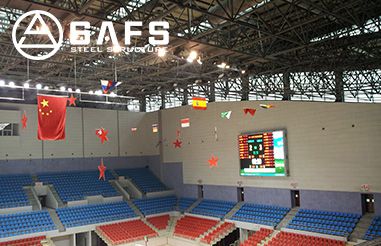Dapeng Town Industrial Park, Tongshan District, Xuzhou City, Jiangsu Province, China
Prestressed steel structure is an advanced structural form that combines prestressing technology with steel structure. In recent years, with the development of the construction industry, this technology has made remarkable progress in innovation and has been widely applied in many fields.
1.Innovation of prestressed steel structure technology
(1) New type of prestressing system
Tension cable – Tie rod hybrid system
Combine the advantages of tension cables and tie rods and arrange them reasonably in the structure. The cables can effectively bear the tensile force, while the tie rods excel in compression resistance and stability. This hybrid system can flexibly distribute prestress according to the structural stress characteristics, optimise the distribution of internal forces and improve the overall performance of the structure. For example, in a large-span space structure, tensile cables are used in the main tension areas, and tie rods are used to strengthen the local compression or stabilise the weak points.
Adjustable prestressing system
A system has been developed that allows the amount of prestressing to be adjusted during the use of the structure. Through the use of special anchorage devices and adjustment mechanisms, the prestressing value can be adjusted in real time according to the actual stress state of the structure and environmental changes (e.g. temperature changes, load changes, etc.). This not only enhances the adaptability of the structure to complex working conditions, but also extends the service life of the structure.
(2) Innovation of prestressing application method
Intelligent prestressing application technology
An intelligent system composed of sensors, controllers and actuators is used to apply prestress. The sensor monitors the stress, strain and deformation of the structure in real time, the controller calculates the optimal prestressing application value and speed based on the monitoring data, and the actuator accurately executes the prestressing application operation. This technology improves the precision and efficiency of prestressing application and reduces the influence of human factors.
Local Prestressing Strengthening Technology
A local prestressing strengthening method has been developed for areas of complex local stresses or stress concentrations in steel structures. By adopting special prestressing application process in these key areas, such as small jacks and local tension cable arrangement, the bearing capacity and stability of the local structure can be improved in a targeted manner, and the overall structural failure triggered by local damage can be avoided.
(3) Integration and innovation with new materials and technologies
Application of high-performance materials
Combine high-performance steel, fibre-reinforced composite materials and prestressed steel structure. High-performance steel has higher strength and toughness, and can withstand greater prestress. Fibre-reinforced composites have the advantages of light weight, high strength, corrosion resistance, etc., which can be used to make tension cables or reinforce the steel structure to further enhance the performance of pre-stressed steel structure.
Combined with 3D technology
Explore the use of 3D printing in prestressed steel structures. 3D printing can be used to manufacture complex shaped prestressed members or nodes, which can achieve design requirements that are difficult to achieve by traditional manufacturing methods. At the same time, pre-stressing tendons or cords can be directly embedded into the members during 3D printing, which improves the structural integrity and the convenience of pre-stressing application.
2.Application of prestressed steel structure technology
(1) Large-span building field
Stadium
Prestressed steel structure is widely used in the roof structure of stadiums. For example, a large stadium roof adopts prestressed mesh frame or cable membrane structure, which can realise super-large span coverage and meet the spatial requirements of the playing field and spectators’ seats, and at the same time ensure the stability of the structure under the action of wind load, snow load and seismic load through the pre-stressing technology.

Exhibition halls and conference centres
Prestressed steel structures provide an ideal solution for exhibition halls and conference centres that require large, column-free spaces. It can achieve flexible separation of large-span space and diversified architectural shapes through reasonable prestressing arrangement, while ensuring structural safety and economy.
(2) Bridge Engineering Field
Cable-stayed Bridge
Cable-stayed bridge is a typical representative of prestressed steel structure application. By setting up cable-stayed cables and applying prestressing between the bridge tower and the main girder, the load of the main girder is transferred to the bridge tower, which effectively reduces the bending moment of the main girder and increases the spanning capacity of the bridge. Modern cable-stayed bridges are constantly innovated in terms of cable material, anchoring system and prestressing adjustment, which improves the durability and carrying capacity of the bridge.
Suspension Bridge
The main cables of suspension bridges usually adopt prestressing technology. During the manufacturing and installation of the main cables, the linear shape and internal force of the main cables are adjusted by applying prestressing to ensure the force performance of the bridge under constant load and live load. At the same time, prestressing technology is also applied in the stiffening beams, suspension rods and other components of suspension bridges, which improves the stability of the entire bridge structure.
(3) Industrial building field
Large-span factory buildings
In industrial plants, especially those with large crane operations or those that require large span space for placing production equipment, prestressed steel can be used in structures such as roof frames and crane girders. The application of prestressing can improve the load carrying capacity and fatigue resistance of these structures to meet the heavy load and frequent use requirements of industrial production.